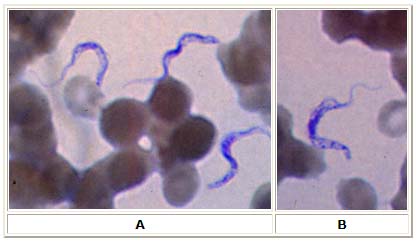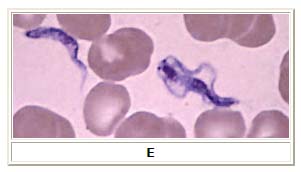African trypanosomiasis laboratory findings: Difference between revisions
Aditya Ganti (talk | contribs) |
No edit summary |
||
| Line 4: | Line 4: | ||
==Overview== | ==Overview== | ||
The diagnosis of [[African trypanosomiasis]] rests | The diagnosis of [[African trypanosomiasis]] rests on demonstrating [[trypanosomes]] by [[microscopic examination]] of [[chancre]] fluid, [[lymph node]] aspirates, [[blood|blood]], [[bone marrow|bone marrow]], and [[cerebrospinal fluid]] in the late stages of [[infection]]. | ||
==Laboratory Findings== | ==Laboratory Findings== | ||
The diagnosis of [[African trypanosomiasis]] rests | The diagnosis of [[African trypanosomiasis]] rests on demonstrating [[trypanosomes]] by [[microscopic examination]] of [[chancre]] fluid, [[lymph node]] aspirates, [[blood]], [[bone marrow]] or, in the late stages of [[infection]], in [[cerebrospinal fluid]]. | ||
===Blood smear=== | ===Blood smear=== | ||
*Acute disease is often diagnosed by visual detection of the ''[[Trypanosoma brucei rhodesiense]] '' [[Parasites|parasite]] on [[peripheral blood smear]]. | *Acute disease is often diagnosed by visual detection of the ''[[Trypanosoma brucei rhodesiense]] '' [[Parasites|parasite]] on [[peripheral blood smear]]. | ||
| Line 17: | Line 17: | ||
|[[Image:African trypanosomiasis.jpg|left|African trypanosomiasis]] | |[[Image:African trypanosomiasis.jpg|left|African trypanosomiasis]] | ||
| | | | ||
* Thin blood smear stained with Giemsa. | * Thin blood smear stained with [[Giemsa stain|Giemsa]]. | ||
* Typical trypomastigote stages (the only stages found in patients), with a posterior kinetoplast, a centrally located nucleus, an undulating membrane, and an anterior flagellum. | * Typical trypomastigote stages (the only stages found in patients), with a posterior kinetoplast, a centrally located nucleus, an undulating membrane, and an anterior flagellum. | ||
* The two [[Trypanosoma brucei]] species that cause human trypanosomiasis, [[Trypanosoma brucei gambiense]] and [[Trypanosoma brucei rhodesiens]], are indistinguishable morphologically. | * The two ''[[Trypanosoma brucei]]'' species that cause human trypanosomiasis, ''[[Trypanosoma brucei gambiense]]'' and ''[[Trypanosoma brucei rhodesiens]]'', are indistinguishable morphologically. | ||
* The trypanosomes length range is 14 to 33 µm. | * The trypanosomes' length range is 14 to 33 µm. | ||
|- | |- | ||
|[[Image:African trypanosomiasis 5.jpg|left|African trypanosomiasis 5]] | |[[Image:African trypanosomiasis 5.jpg|left|African trypanosomiasis 5]] | ||
| Line 29: | Line 29: | ||
===Electrolyte and Biomarker Studies=== | ===Electrolyte and Biomarker Studies=== | ||
*Serology is not usually helpful in acute disease. | *Serology is not usually helpful in acute disease. | ||
*Detection of anti-trypanosomal [[IgG]] antibodies is helpful to detect | *Detection of anti-trypanosomal [[IgG]] antibodies is helpful to detect African trypanosomiasis infections. | ||
*Three serological tests are available for detection of the parasite | *Three serological tests are available for detection of the parasite: micro-CATT, wb-CATT, and wb-LATEX. The first uses dried blood while the other two use whole blood samples. | ||
*wb-CATT | *wb-CATT is the most efficient for diagnosis, while wb-LATEX is a better exam for situations in which greater [[sensitivity]] is required.<ref>{{cite journal |author=Truc P, Lejon V, Magnus E, ''et al.'' |title=Evaluation of the micro-CATT, CATT/Trypanosoma brucei gambiense, and LATEX/T b gambiense methods for serodiagnosis and surveillance of human African trypanosomiasis in West and Central Africa |journal=Bull. World Health Organ. |volume=80 |issue=11 |pages=882–6 |year=2002 |pmid=12481210 |pmc=2567684 |doi= |url=}}</ref> | ||
*Detection of antibodies among [[infants]] may be difficult due to the presence of maternal [[antibodies]] early following birth. Accordingly, serologic testing for [[infants]] is only recommended at least 9 months after birth. | *Detection of antibodies among [[infants]] may be difficult due to the presence of maternal [[antibodies]] early following birth. Accordingly, serologic testing for [[infants]] is only recommended at least 9 months after birth. | ||
Revision as of 20:12, 9 August 2017
|
African trypanosomiasis Microchapters |
|
Diagnosis |
|---|
|
Treatment |
|
Case Studies |
|
African trypanosomiasis laboratory findings On the Web |
|
American Roentgen Ray Society Images of African trypanosomiasis laboratory findings |
|
Risk calculators and risk factors for African trypanosomiasis laboratory findings |
Editor-In-Chief: C. Michael Gibson, M.S., M.D. [1]; Associate Editor(s)-In-Chief: Pilar Almonacid; Jesus Rosario Hernandez, M.D. [2]
Overview
The diagnosis of African trypanosomiasis rests on demonstrating trypanosomes by microscopic examination of chancre fluid, lymph node aspirates, blood, bone marrow, and cerebrospinal fluid in the late stages of infection.
Laboratory Findings
The diagnosis of African trypanosomiasis rests on demonstrating trypanosomes by microscopic examination of chancre fluid, lymph node aspirates, blood, bone marrow or, in the late stages of infection, in cerebrospinal fluid.
Blood smear
- Acute disease is often diagnosed by visual detection of the Trypanosoma brucei rhodesiense parasite on peripheral blood smear.
- Peripheral blood smears are usually stained with Giemsa stain for adequate visualization of the parasite.
| Microscopy | Findings |
|---|---|
 |
|
 |
|
Electrolyte and Biomarker Studies
- Serology is not usually helpful in acute disease.
- Detection of anti-trypanosomal IgG antibodies is helpful to detect African trypanosomiasis infections.
- Three serological tests are available for detection of the parasite: micro-CATT, wb-CATT, and wb-LATEX. The first uses dried blood while the other two use whole blood samples.
- wb-CATT is the most efficient for diagnosis, while wb-LATEX is a better exam for situations in which greater sensitivity is required.[1]
- Detection of antibodies among infants may be difficult due to the presence of maternal antibodies early following birth. Accordingly, serologic testing for infants is only recommended at least 9 months after birth.
Gallery
-
African trypanosomiasis. Adapted from Public Health Image Library (PHIL). [2]
-
African trypanosomiasis. Adapted from Public Health Image Library (PHIL). [2]
-
African trypanosomiasis. Adapted from Public Health Image Library (PHIL). [2]
-
African trypanosomiasis. Adapted from Public Health Image Library (PHIL). [2]
-
African trypanosomiasis. Adapted from Public Health Image Library (PHIL). [2]
-
African trypanosomiasis. Adapted from Public Health Image Library (PHIL). [2]
-
African trypanosomiasis. Adapted from Public Health Image Library (PHIL). [2]
-
African trypanosomiasis. Adapted from Public Health Image Library (PHIL). [2]
References
- ↑ Truc P, Lejon V, Magnus E; et al. (2002). "Evaluation of the micro-CATT, CATT/Trypanosoma brucei gambiense, and LATEX/T b gambiense methods for serodiagnosis and surveillance of human African trypanosomiasis in West and Central Africa". Bull. World Health Organ. 80 (11): 882–6. PMC 2567684. PMID 12481210.
- ↑ 2.0 2.1 2.2 2.3 2.4 2.5 2.6 2.7 "Public Health Image Library (PHIL)".
![African trypanosomiasis. Adapted from Public Health Image Library (PHIL). [2]](/images/f/f9/African_trypanosomiasis01.jpg)
![African trypanosomiasis. Adapted from Public Health Image Library (PHIL). [2]](/images/1/1c/African_trypanosomiasis02.jpeg)
![African trypanosomiasis. Adapted from Public Health Image Library (PHIL). [2]](/images/5/5f/African_trypanosomiasis03.jpeg)
![African trypanosomiasis. Adapted from Public Health Image Library (PHIL). [2]](/images/3/33/African_trypanosomiasis05.jpeg)
![African trypanosomiasis. Adapted from Public Health Image Library (PHIL). [2]](/images/f/f8/African_trypanosomiasis06.jpeg)
![African trypanosomiasis. Adapted from Public Health Image Library (PHIL). [2]](/images/c/c9/African_trypanosomiasis07.jpeg)
![African trypanosomiasis. Adapted from Public Health Image Library (PHIL). [2]](/images/6/6d/African_trypanosomiasis08.jpeg)
![African trypanosomiasis. Adapted from Public Health Image Library (PHIL). [2]](/images/2/29/African_trypanosomiasis09.jpeg)